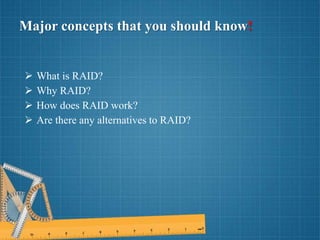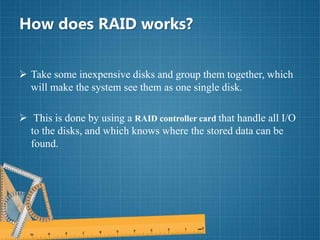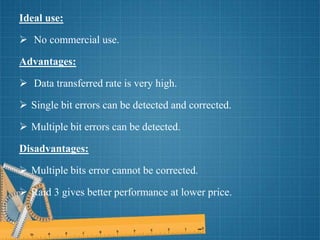RAID LEVELS
- 1. RAID LEVELS UZAIR KHAN MUHAMMAD SHAHAB
- 2. Contents: Introduction Abstract Major concepts Raid Levels Conclusion Reference
- 3. Introduction: RAID stands for Redundant Array of Independent Disks or Redundant Array of Inexpensive Disks. RAID is an example of storage virtualization and was first defined by David Patterson in 1987. RAID is a storage technology that combines multiple disk drive components into a logical unit
- 4. Abstract: Storage scheme using multiple hard drives to share or replicate data among the drives. It provide data integrity, fault-tolerance, throughput or capacity compared to single drives. Instead of seeing several different hard drives, the OS sees only one. Typically used on server computers, advanced personal computers.
- 5. Major concepts that you should know! What is RAID? Why RAID? How does RAID work? Are there any alternatives to RAID?
- 6. What is RAID? Redundant Array of Inexpensive Disks. Basic idea is to connect multiple disks together to provide Large storage capacity Faster access to reading data Redundant data
- 7. Why RAID? RAID system provides data redundancy, fault tolerance, increased capacity and increased performance. RAID has for a long time been something that you only find in large server systems, but lately cheaper RAID controller card have made it possible to get a RAID system even for small servers and home computers.
- 8. How does RAID works? Take some inexpensive disks and group them together, which will make the system see them as one single disk. This is done by using a RAID controller card that handle all I/O to the disks, and which knows where the stored data can be found.
- 9. RAID controller: A RAID controller is a hardware device or software program used to manage hard disk drives (HDDs) or solid-state drives (SSDs) in a computer or storage array so they work as a logical unit.
- 10. Are there any alternatives to RAID? At the Berkeley University of California they perform researches about alternative solutions. Such a solution is RADD, or Redundant Array of Distributed Disks. RADD: can support redundant copies of data across a computer network at the same space cost as RAID: do for local data. Such copies increase availability in the presence of both temporary and permanent failures (disasters) of single site computer systems as well as disk failures.
- 11. RAID LEVELS: RAID 0 – striping RAID 1 – mirroring RAID 2 – redundancy through Hamming RAID 3 – bit interleaved Parity RAID 4 – block interleaved Parity RAID 5 – striping with parity
- 12. LEVEL 0 (striping): Striping means that each file is split into blocks of a certain size and those are distributed to the various drives. Offers superior I/O performance. Performance can be enhanced further by using multiple controllers.
- 13. Ideal use: Photoshop image retouching station. Advantages: Offers great performance. There is no overhead caused by parity controls. Easy to implement. Disadvantages: Not fault-tolerant. It should not be used on mission-critical systems
- 14. LEVEL 1 (mirroring): Mirroring means duplication of data i.e Data are stored twice. Writing them to both the data disk and a mirror disk . The controller uses either the data drive or the mirror drive for data recovery.
- 15. Ideal use: Accounting systems. Advantages: Data do not have to be rebuild. Disadvantages: Storage capacity is only half of the total disk capacity .
- 16. LEVEL 2 (redundancy through Hamming): Bit-level striping means that the file is broken into “bit-sized pieces”. It uses a Hamming code for error correction.
- 17. Ideal use: No commercial use. Advantages: Data transferred rate is very high. Single bit errors can be detected and corrected. Multiple bit errors can be detected. Disadvantages: Multiple bits error cannot be corrected. Raid 3 gives better performance at lower price.
- 18. LEVEL 3 (bit interleaved Parity): Byte-level striping means that the file is broken into "byte- sized pieces“. Written in parallel on two or more drives. An additional drive stores parity information.
- 19. Ideal use: Video streaming. Advantages: It provides high throughput for large data transfers. Disk failures do not significantly slow down throughput. Disadvantages: Performance is slower for random, small I/O operations.
- 20. LEVEL 4 (block interleaved Parity): Block-level striping means that each file is split into blocks of a certain size . Allows each member to act independently when only a single block is requested. Service multiple read requests simultaneously.
- 21. Ideal use: Enterprise level company to use it is Net App. Advantages: Reading operations are very fast. Fault tolerance is very high. Disadvantages: In degraded mode, its reading operation becomes slow. Writing operation on disks is extremely slow.
- 22. LEVEL 5 (striping with parity): Most common secure RAID level. Except that data are transferred to disks by independent read and write operations. Instead of a dedicated parity disk, parity information is spread across all the drives.
- 23. Ideal use: Application servers. Advantages: Read data transactions are very fast while write data are somewhat slow. Disadvantages: Disk failures have an effect on throughput. This is complex technology.
- 24. Conclusion: Overall it provides systems with a variety of benefits depending upon the version implemented. Most users will likely opt to use the RAID 0 for increased performance without the loss of storage space. This is primarily because redundancy is not an issue for the average user.
- 25. References: Jimmy Person (pt98jpr) Gustav Everson (pt99gev) Blekinge Institute of Technology, Sweden Garth Gibson, Randy H.Katz David A. Paterson, Martin schulze University of California •
- 26. ANY QUERY ?
- 27. THANKS !


























